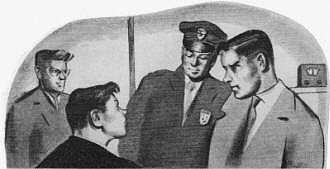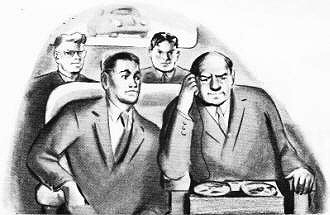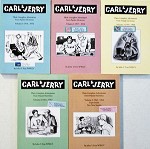Carl & Jerry: Electronic Eraser
|
|||||||
Teenage amateur sleuths, cum amateur radio operators, cum high-tech pranksters, cum serious electronics experimenters Carl Anderson and Jerry Bishop save the day once again with a cleverly devised device for erasing the contents of a tape recording. Their assignment, done at the behest of a secretive government agent, might have been made easier if they had had access to the super-strong rare earth neodymium magnets of today since a stereo speaker magnet would not do the job. Instead, the pair was forced to resort to a more challenging solution. As is author Frye's style, in this 1962 issue of Popular Electronics magazine he educates you on the workings of tape recorder erasing circuitry and functionality in the process of telling the story. Carl & Jerry: Electronic Eraser
Carl, Jerry, Police Chief Morton, and a pale, young, well-dressed stranger were engaged in serious conversation in the boys' basement laboratory. "I need rather specialized help in a hurry," young Mr. Adams was saying. "When I talked to the department head ... of the Federal agency for which I work, I explained the situation to him, and told him where I was, he remembered that you boys had helped another of our operators about a year ago. He says you designed a small transmitter that fitted inside a dog's collar and enabled our agent to get some valuable information." "Sure; that was Mr. Cody, a big fellow who was light on his feet and gave out next to nothing in the way of information," Carl recalled. "Sounds like Cody," the pleasant stranger said with a wan smile. "Anyway, I was told to contact you through Chief Morton and see what you could do. I'm afraid, like Mr. Cody, I can only divulge just the information you must have to understand the problem; but believe me, this affair is important to every living American. "Tonight at ten a man will board a bus leaving here for Center City. He will be carrying a small tape recording, probably in a briefcase. On the bus will be another man waiting to receive the tape. After it changes hands, the receiver of the tape will somehow check the recording to make sure it's what he wants. If he is satisfied, a large sum of money will be given to the man who surrenders the tape. "Now it's most essential, first, that the men do not know they are under surveillance; second, that the tape not change hands; and third, if at all possible, that the tape itself be destroyed. Can you men, with your background of electronics, think of any way these three objectives might be accomplished ?" "Am I right in believing it's the material recorded on the tape that you don't want to change hands rather than the physical tape itself?" Jerry asked. "That's right, but what are you driving at?" "I was thinking of some method by which we might erase the tape without its ever leaving the possession of the man who has it now." "And without his knowing that it was being erased?" [borders/_temp/2-28-2024/google-300x250-ad-unit-included-file-left.htm]"Yes," said Jerry. "I'm not at all sure it can be done, but suppose you give Carl and me about three hours - until 8 p.m., say - to do some experimenting. In the meantime, perhaps you'd better be thinking up a second plan to use in case we strike out." "I like the way you think - " Mr. Adams started to say as he rose to his feet, but suddenly he gasped and nearly doubled over in pain. "Guess I got kind of a catch in my side," he explained as he straightened up. "I'll be back at eight to see what you've found out, but I surely hope you come up with something. I don't seem to be thinking too well today, and I ran out of ideas before I came here." Sounds to me as though you're biting off quite a chunk, old buddy," Carl observed after the other two had left. "That business about the men not knowing any hanky-panky is going on while their precious tape is being erased is the toughie. What do you have in mind? Rubbing a big permanent magnet over the guy's briefcase?" "It's worth trying," Jerry answered promptly. "Let's do some experimenting and see what kind of results we can get with brute force d.c. erase - that's the name applied to using a permanent magnet to erase a recording from a tape." It didn't take the boys long to convince themselves that this approach showed little promise. A very strong alnico magnet out of a speaker had to be almost in contact with the tape to erase the recording completely. When a quarter-inch of space was kept between the magnet and a recorded reel of tape, only a very slight weakening of the recording was noticed. "I was afraid of that," Jerry observed. "We must be able to work through a distance of at least a quarter of an inch to allow for the thickness of the leather in the man's briefcase, a cardboard container for the tape, etc. You see, a d.c. erase system on a tape recorder doesn't consist simply of a method of passing a tape over a strong permanent magnet. That's only the first step, which leaves the tape in a very strongly magnetized condition. It must then be passed over a weaker magnet of opposite polarity, or sometimes several magnets of alternating polarity or a magnet with a diagonal gap in it, so that the end result is a tape which is completely demagnetized. That's what we need, some way of literally bathing the recording right through the briefcase with an alternating, diminishing magnetic field." "And how do we do that?" "Let's try to construct a portable, battery-operated bulk eraser. As you know, a bulk eraser is simply a strong electromagnet with 60-cycle a.c. going through its coil. As a reel of tape is subjected to this strong reversing field and then gradually withdrawn, the little magnetic particles of the tape are first jerked violently in unison out of their recorded pattern and then are subjected to weaker and weaker pushing and tugging forces that eventually leave them lying in the unpatterned disarray of virgin tape." "Don't you think it's going to be a little difficult to get a.c. out of your batteries - or are you going to use a.c. batteries ?" "Don't be cute. We can get a first cousin of a.c., pulsing d.c., simply by using an interrupter between the batteries and our coil," Jerry retorted. "Suppose you see what you can do about converting this old 6-volt auto radio vibrator into a simple interrupter while I get started winding a magnet." Jerry started by boring a small hole in the center of a 2"-diameter, 1"-thick piece of soft iron; a bolt passed through this hole was able to hold two circles of plywood clamped against the sides of the iron core. Next, he cut several short pieces of plastic electrician's tape and looped them down into the space between the two pieces of plywood with their sticky sides turned away from the wood and iron. Then he chucked the end of the bolt in his electric drill and wound layer after layer of #20 enameled wire on the core. Jerry did his best to wind the wire in tight, even layers as the electric drill rotated the core, and he kept at it until his bobbin of wire was some five or six inches in diameter. Next, he carefully lapped the loose ends of each piece of tape over each other to hold the wire securely in place while he removed the wooden sides and pushed the iron core out of the middle. Now, very carefully, he wrapped the whole doughnut of wire with thin plastic tape and then forced the soft iron core back into the center. By this time Carl had the vibrator reworked, and it was connected to a battery eliminator and the coil so that the heavy contacts of the vibrating reed connected and disconnected the six-volt d.c. supply to the coil at a rate of about 115 cycles per second. A capacitor substitute box was connected across the points of the interrupter and adjusted for minimum arcing; then a capacitor of this value was soldered in place. Finally, the boys placed an issue of Popular Electronics on top of the coil, laid a reel of recorded tape on top of that, and turned on the battery substitute. The tape was slid around on the magazine for a few seconds and then lifted away before the power was cut off. When the tape was placed on the recorder and run through in the "Play" position, not a sound - except for a slight hiss - came from the recorder speaker. "That does it!" Jerry exclaimed jubilantly. "Now let's get busy installing this rat's nest and some parallel heavy-duty six-volt lantern batteries in that old attaché case of Dad's upstairs. We want plenty of current, for the magnetic field is dependent on ampere-turns. Mr. Adams should be here in an hour, and I want to be able to give him a convincing demonstration." First they cut a hole in the side of the case so that one side of the coil could be mounted flush with the surface of the leather. This opening was concealed with brown press-on paper that was used to cover the entire case. The batteries were anchored in place, and the vibrator was wrapped in several layers of sound-insulating foam rubber. Wires were run through the handle to a simple push-button switch which could be operated easily with one finger. "We want to have our magnet just as close as possible to that reel of tape," Jerry said as he smoothed the thin paper over the magnet core. "The strength of a magnetic field is inversely proportional to the distance, and it works on a square law. Plus or minus a sixty-fourth of an inch might spell the difference between success or failure in our completely erasing that tape." He was interrupted by the arrival of Mr. Adams and Chief Morton. The former looked even paler than he had that afternoon, and bent over a little. Quickly the boys explained what they had done. They let Mr. Adams hear a few feet of recorded tape and then placed the reel of tape in a briefcase. While Jerry walked around the basement dangling this case from one arm, Carl brushed against him with the attaché case. In spite of what seemed to be a very brief and casual contact between the briefcase and the attaché case, the tape was found to be completely blank when it was placed on the recorder. "Guess we better show you how to work it; we haven't much time," Jerry offered. "Boys, I have bad news for you," Mr. Adams said as he wiped cold sweat from his forehead. "You're going to have to use that gadget yourself. The doctor is waiting for me in a squad car outside, and I must go straight from here to the hospital for an emergency appendectomy. "This is a picture of the man who will have the tape," he went on. "You should be able to spot him in the bus station. And here are two round-trip tickets for the bus to Center City. Good luck!" With that, Chief Morton half-led, half carried Mr. Adams through the door and up the outside basement steps. Meanwhile, Carl and Jerry stared at each other in pop-eyed amazement. "Well," Carl finally said, "I guess we better get started. You wrap up in your cloak while I dash over and get my dagger!" I Spite of their joking, both boys had a feeling of rising excitement as they parked their car across the street from the bus station. They spotted their man as soon as they entered the door, even though he was not wearing dark glasses, had no beard, and looked amazingly like any ordinary businessman. But he also happened to look exactly like the picture in Jerry's shirt pocket, and a thin briefcase rested on his knees. Out of the corners of their eyes, the boys could actually make out the square outline of the cardboard container for a 3" reel of tape through the leather. It seemed to Carl and Jerry the bus would never come, but finally it did. As the stranger stood up with his briefcase in his right hand, Jerry transferred the attaché case to his left hand and followed the man closely. At the door of the bus there was a little knot of people awaiting the alighting passengers before they started getting on, and it was here Jerry had his chance. While Carl stood on the man's left and asked him something about whether the bus was on time or not, Jerry pushed the switch under his finger and brushed his case lightly against the briefcase, rubbing it around with a circular motion. The man never noticed. The bus was not crowded. Carl and Jerry followed their man to the rear, where he selected a seat alongside of a short fat man who was dictating letters in a low voice into the microphone of a portable tape recorder that was resting on his knees. The two men apparently took no notice of each other until the bus was a dozen miles out of town. Then the man with the briefcase turned to the other and said, "Pardon me, sir, but I wonder if you might do me a great favor. I have a tape here sent me by my nephew in the army overseas, but I have no recorder. Could you possibly let me hear it on your machine ?" "Why, certainly; just let me have it and I'll get it started for you," the fat man answered obligingly. As Carl and Jerry watched tensely, the fat man took the tape from the brief-case and put it on the machine. Then he put the listening earpiece in his ear and started the tape moving. After a few seconds he began to frown and he threw a switch that sent the tape whirring at a faster speed. Next he turned the tape over and tried to listen to the other side. Finally he handed the earpiece to the first man and said coldly, "Your nephew is a practical joker. There is absolutely nothing on that tape. Hear for yourself." The man trying to sell the tape listened to every inch of it with growing puzzlement and dejection. "I don't understand it; I don't understand it at all," he muttered over and over. "You'd better tell your nephew practical jokes can be dangerous," the little fat man said menacingly as he turned his back and stared out the window. At Center City Carl and Jerry followed their man outside the bus station. As he walked past an alley, he impulsively tore the reel of tape from his pocket and tossed it into an ash can. The boys retrieved it and took the next bus home. Chief Morton was waiting for them at the station, and the three of them went to the hospital. There Mr. Adams was out from under the anesthetic, and he was delighted at what the boys told him. "Well done!" he said weakly. "If this keeps up, we're going to have to put you on our payroll. Seriously, though, you'll hear more about this as soon as I'm back on my feet and send in my report. In the meantime, boys, you've done a great service for your country - greater than you realize." "As far as I can see, all we've done is get tangled up in some government tape," Carl said jokingly as they headed for the door.
Posted September 5, 2023
|
|||||||

 By John T. Frye W9EGV
By John T. Frye W9EGV


 Carl & Jerry, by John T. Frye
Carl & Jerry, by John T. Frye